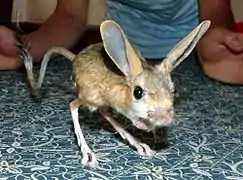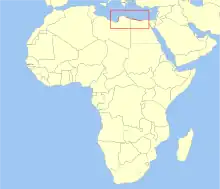Four-toed jerboa
The four-toed jerboa (Scarturus tetradactyla) is a rodent of the family Dipodidae and genus Scarturus that has four digits. Four-toed jerboas are native to Egypt and Libya. They live in coastal salt marshes and dry deserts.
| Four-toed jerboa | |
|---|---|
 | |
| Scientific classification | |
| Domain: | Eukaryota |
| Kingdom: | Animalia |
| Phylum: | Chordata |
| Class: | Mammalia |
| Order: | Rodentia |
| Family: | Dipodidae |
| Genus: | Scarturus Gloger, 1841 |
| Species: | S. tetradactyla |
| Binomial name | |
| Scarturus tetradactyla Lichtenstein, 1823 | |
 | |
| Geographic range | |
Physical appearance
Similar to the other jerboas in the genera Allactaga and Scarturus, the four-toed jerboa are small hopping rodents with large ears and a long tail, with a black band near the white, feathery tip. The tail assists and serves as support when the jerboa is standing upright.[2] They have long hind feet and short forelegs.[3] The pelt of the four-toed jerboa is velvety in texture and the upper-parts are speckled black and orange, the rump orange, and the sides gray. The four-toed jerboa hind-limbs have an extra digit compared to other jerboas in the genus Allactaga. The extra digit is smaller in size and nonfunctional compared to the other three digits.[4]
Nutrition
Emerging at night, the four-toed jerboa eats grass, leaves, and soft seeds.[5] The low crown molars and soft palates help the four-toed jerboa chew plant material and seeds.[6]
The four-toed jerboa is a host of the acanthocephalan intestinal parasite Moniliformis aegyptiacus.[7]
Conservation status
The four-toed jerboa was listed as on the IUCN Red List of Threatened Species. They are at very high risk of extinction due to habitat loss and restricted range.
References
- Gerrie, R.; Kennerley, R. (2017). "Allactaga tetradactyla". IUCN Red List of Threatened Species. 2017: e.T850A22201540. doi:10.2305/IUCN.UK.2017-2.RLTS.T850A22201540.en. Retrieved 18 November 2021.
- Kirmiz, John P. Adaptation to Desert Environment; A Study on the Jerboa, Rat and Man. London: Butterworths, 1962. 17. Print.
- Lagassé, Paul. "Jerboa." The Columbia Encyclopedia. 6th ed. New York: Columbia UP, 2000. Academic Search Premier. Web. 1 Oct. 2013.
- Shahin, A (2005). "Growth and Maturation of Metatarsals and Their Taxonomic Significance in the Jerboas Allactaga and Jaculus (Rodentia: Dipodidae)". Acta Zoologica. 86 (2): 82. doi:10.1111/j.1463-6395.2005.00189.x.
- Holden, M. E. and G. G. Musser. 2005. Family Dipodidae. pp. 871–893 in Mammal Species of the World a Taxonomic and Geographic Reference. D. E. Wilson and D. M. Reeder eds. Johns Hopkins University Press, Baltimore
- Basyouny Shahin, Adel (1999). "A Comparative Study of the Molar and Soft Palate Characters of the Genera Allactaga and Jaculus (Mammalia: Rodentia) in Egypt". Zoology in the Middle East. 18 (1): 17–32. doi:10.1080/09397140.1999.10637779.
- Guerreiro Martins, Natalia Beatriz; Del Rosario Robles, María; Navone, Graciela Teresa (2017). "A new species of Moniliformis from a Sigmodontinae rodent in Patagonia (Argentina)". Parasitology Research. 116 (8): 2091–2099. doi:10.1007/s00436-017-5508-9. PMID 28585077. Retrieved February 9, 2020.
